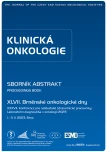XVIII. Nádory jícnu a žaludku
Published in:
Klin Onkol 2023; 36(Supplementum 1): 68
XVIII/46. Intraoperative performance and outcomes of robotic and laparoscopic gastrectomy for gastric cancer – is it worth it?
Pohnán R., Hadač J., Pažin J., Turzová A., Kalvach J.
Chirurgická klinika, 2. LF UK a ÚVN–VFN Praha
Background: Robotic-assisted gastrectomy (RG) is an evolution of laparoscopic procedures, combining elements from open surgical techniques with the advantages of a minimally invasive approach. Studies on RG are currently limited. This study aimed to compare the intraoperative performance as well as short- and mid- term outcomes of RG and laparoscopic gastrectomy (LG). Material and methods: A total of 60 patients (between 18 and 78 years) underwent robotic (N = 19) or laparoscopic (N = 41) gastrectomy between August 2018 and December 2021. The intraoperative performance as well as short- and mid-term outcomes of the robotic and the laparoscopic groups were compared. Total costs and charges for LG/RG were compared based on the payer and hospital cost. Results: The RG group had a lower volume of intraoperative blood loss than the LG group (48.7 vs. 86.4 mL, P = 0.042). The total number of lymph node dissections was higher (27.7 ± 6.4 vs. 18.3 ± 10.22, P < 0.001) in the RG group compared with the LG group. More lymph node dissections at the upper edge of the pancreas were performed in the RG group than in the LG (10.9 ± 3.8 vs. 5.33 ± 4.5, P = 0.001). The overall postoperative morbidity rate was 15.4% in the RTG group and 18.7% in the LG group with no significant difference (P = 0.44), No mortality was observed in either group. The laboratory data (leukocyte/ lymphocyte levels, inflammatory, albumin and amylase) of the RG group were better than those of the LG group. No-significant differences in three-year overall survival (OS) or relapse-free survival (RFS) were observed. RG had higher costs compared to LG and a 0.9-day decrement in the length of stay. Discussion and conclusion: RG in the treatment of gastric cancer has demonstrated surgical and oncological safety. Robotic surgery has advantages over laparoscopic surgery for radical gastrectomy with D2 lymphadenectomy for patients with locally advanced gastric cancer. However, the mid-term efficacies of the two approaches were similar. Robotic surgical systems may reduce surgical stress responses in patients, allowing them shorter recovery and/or to receive postoperative chemotherapy earlier. RG is more costly when compared to LG.
XVIII/222. Novel approaches for HER 2 positive and Claudin 18.2 positive upper GI tumours
Lordick F.
Department of Oncology, Gastroenterology, Hepatology, and Pulmonology, University Cancer Center Leipzig, Germany
Medical therapy for oesophageal and gastric cancer has changed considerably during the past decade. The value of sequential systemic therapy in the advanced setting was established and perioperative chemotherapy has become a standard of care. Nowadays, we are finally entering a period with increments in survival duration for patients with advanced gastro-oesophageal adenocarcinoma. Based on deeper understanding of molecular cancer biology, advances in biomarker-selected treatment stratification and the dynamic translation of immuno-oncology and biomarker research into clinical practice, novel treatment options are occurring on the horizon. HER2 is an increasingly interesting target for treatment of gastro-oesophageal adenocarcinoma. The Keynote-811 investigators reported that trastuzumab plus pembrolizumab yields much higher response rates than trastuzumab alone, when combined with first-line chemotherapy in advanced/metastatic gastro-oesophageal adenocarcinoma. Survival-related results are expected to be presented at an upcoming major oncology meeting and a positive opinion on this new combination has been released by EMA-CHMP. Trastuzumab-deruxtecan (T-DXd) has recently been approved for treatment of HER2-positive gastro-oesophageal adenocarcinoma post treatment with trastuzumab. This approval was based on compelling phase-II-data, while the randomised phase-III Destiny GC-04 study is ongoing. GC-04 compares T-DXd to ramucirumab-paclitaxel. During treatment with T-DXd, patients should be monitored closely for symptoms and signs of interstitial lung disease (ILD) which affects around 10% and can have severe and even lethal outcomes in up to 2%. Novel antibodies such as zanidatamab or margetuximab with high affinity to HER2 and/or pronounced activation of an adaptive immune response are under investigation. Claudin18.2 is a splice variant and member of the tight junction claudin receptor family. Claudin18.2 is mostly cancer-specific with a physiological expression restricted to the heathy stomach mucosa. Zolbetuximab in combination with either FOLFOX or CAPOX chemotherapy proved to be effective in two randomized controlled phase-III studies (SPOTLIGHT and GLOW). These studies enrolled patients with advanced gastro-oesophageal adenocarcinoma with expression of claudin18.2 on ≥ 75% of tumor cells. Progression-free survival and overall survival were prolonged in both studies when zolbetuximab was added to chemotherapy. The main side effects are nausea and vomiting, which is probably due to binding of zolbetuximab to claudin18.2 expressed on the intact gastric mucosa. Besides zolbetuximab, claudin18.2 is a target of various novel drug developments including other highly receptor affine monoclonal antibodies (such as osemitamab), bi-specific antibodies (anti-claudin18.2 and PD-1), antibody-drug conjugates (ADCs) and claudin18.2-directed CAR-T cells. Finally, a brief outlook will be given on novel drug targets being investigated in the field of advanced gastro-oesophageal adenocarcinoma (such as FGFR2, MET amongst others) and on the potential role of targeted drugs in the peri-operative treatment setting.
Labels
Paediatric clinical oncology Surgery Clinical oncologyArticle was published in
Clinical Oncology

2023 Issue Supplementum 1
Most read in this issue
- I. Onkologická prevence a screening
- X. Nežádoucí účinky protinádorové léčby a podpůrná léčba
- III. Follow-up, sledování onkologických pacientů
- XIX. Nádory tlustého střeva a konečníku
